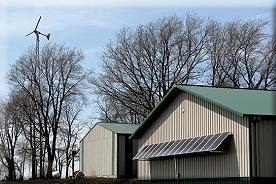Reviewing last week's solar energy news
 While the summer solar boom in the U.S. has subsided for the year, the solar industry is settling into a colorful fall that will keep the industry busy through the rest of 2011 and into early 2012. In addition, two of the largest public solar events in the world occurred last week, the Department of Energy’s (DOE’s) Solar Decathlon and the American Solar Energy Society’s (ASES’s) Nation Solar Tour.
While the summer solar boom in the U.S. has subsided for the year, the solar industry is settling into a colorful fall that will keep the industry busy through the rest of 2011 and into early 2012. In addition, two of the largest public solar events in the world occurred last week, the Department of Energy’s (DOE’s) Solar Decathlon and the American Solar Energy Society’s (ASES’s) Nation Solar Tour.
The DOE’s Solar Decathlon took place last week on the National Mall in Washington, D.C. The biennial event invites teams from around the world to design and build solar-powered, energy-efficient homes to show the world what is possible in terms of a cost-effective home. The 19 homes, hailing from four continents and five countries were open to the public from Sept. 23 to Oct. 2, during which they competed in 10 contests to determine which was the overall winner.
The competition is also a chance for the public to see, firsthand, how they can integrate solar into their homes today.
People unable to make the Solar Decathlon in Washington, D.C., also had the opportunity last weekend to see homes whose owners chose to go solar. The majority of the U.S. held local solar tour events as part of the National Solar Tour, organized by ASES. It’s the 16th year for the tour, and organizers estimated 3,200 communities across the U.S. and in Puerto Rico participated in the event. While the majority of tours were held on Oct. 1 and some before, some communities are holding their events later in October.
If you’re interested, check NationalSolarTour.org
To help more homeowners go solar without shelling out a ton of money upfront, the solar lease is becoming more and more popular. Constellation Energy, a multi-state utility recently joined the fray by supporting solar leases through Maryland-based Astrum Solar. While most residential solar leasing companies got their start on the West coast, Astrum is expanding through its territories in the Eastern U.S., offering solar leases in Maryland, New Jersey, New York, Massachusetts, Ohio and Pennsylvania.
Last week also saw another interesting move into the solar leasing market. OneRoof Energy established a new, $50 million fund to support residential solar leases that are installed as part of the roofing process for new and existing homes. The tax equity fund comes from U.S. Bancorp (NYSE:USB) subsidiary, Black Coral Capital. As part of its SolarSelect Lease the company works to match photovoltaics with the homeowners’ roofs, whether the roof has asphalt roof tiles, ceramic tiles like Spanish style roofs or other types of rooftops.
Hate it or love it, Walmart increased its green cred last week when it announced that it is on track to get a majority of its power from renewable energy in just two years. The retailer giant said it would install solar on 60 more of its California stores through an agreement with SolarCity. When completed, its California stores will get 75 percent of their energy from renewables by 2013.
A problem plaguing the solar and wind industries has been intermittency. To help offset this, companies are continuing to develop solar energy storage technologies. Some, like S&C Co.’s Prosperity Energy Storage Project in Albuquerque, N.M., are using batteries to condition and store electricity from solar installations to help balance the load.
Still others, like Principal Solar, are looking to more innovative solutions. In this case, Principal Solar is developing its Gravity Power Modules using pumped storage hydropower. The device absorbs excess energy produced and uses gravity and water to store excess energy from a power system that can release the power as needed for the grid.
Such storage systems could help, particularly as more utility-scale solar and wind projects come online.
Most of these projects are occurring in the U.S. Southwest, but the Southeast will soon see its first gigantic solar project, thanks to National Solar Group. The company announced that it will start building its first 400-megawatt solar farm in Gadsden County, Florida. The system will consist of 20, 20-acre solar farms built throughout the county, according to the company.
Image courtesy of the Illinois Solar Tour 2011.



